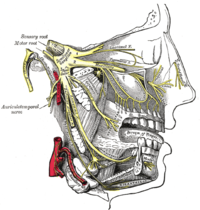
Photo from wikipedia
Background Because the results of clinical trials of investigational treatments influence regulatory policy, prescribing patterns, and use in clinical practice, high quality trials are an essential component of the evidence… Click to show full abstract
Background Because the results of clinical trials of investigational treatments influence regulatory policy, prescribing patterns, and use in clinical practice, high quality trials are an essential component of the evidence base for migraine. The International Headache Society has published guidelines for clinical trials in adults with migraine since 1991. With multiple issues specific to children and adolescents with migraine, as well as the emergence of novel trial designs and advances in pharmaceuticals, biologics, devices, and behavioural interventions, there is a need for guidance focusing on issues specific to the conduct of clinical trials in children and adolescents with migraine. Objectives The objective of these guidelines is to provide a contemporary, standardized, and evidence-based approach to the design, conduct, and reporting of well-controlled clinical trials of preventive treatment of migraine in children and adolescents. Methods The development of these guidelines was based on guidelines previously published by the International Headache Society and regulatory bodies. The recommendations are evidence-based, where available. The process included consultations among various committees, roundtable discussions among stakeholders (lay people and the pharmaceutical industry), and open consultation with the IHS membership on the final draft. Results A series of recommendations addressing the major issues in clinical trials in children and adolescents with migraine is provided. Recommendations are supported by evidence-based practice and validated methodologies, where available. Supporting comments are provided to clarify ambiguities. Conclusions These guidelines should be consulted and used in designing and conducting clinical trials of preventive treatments in children and adolescents with migraine.
Journal Title: Cephalalgia
Year Published: 2019
Link to full text (if available)
Share on Social Media: Sign Up to like & get
recommendations!